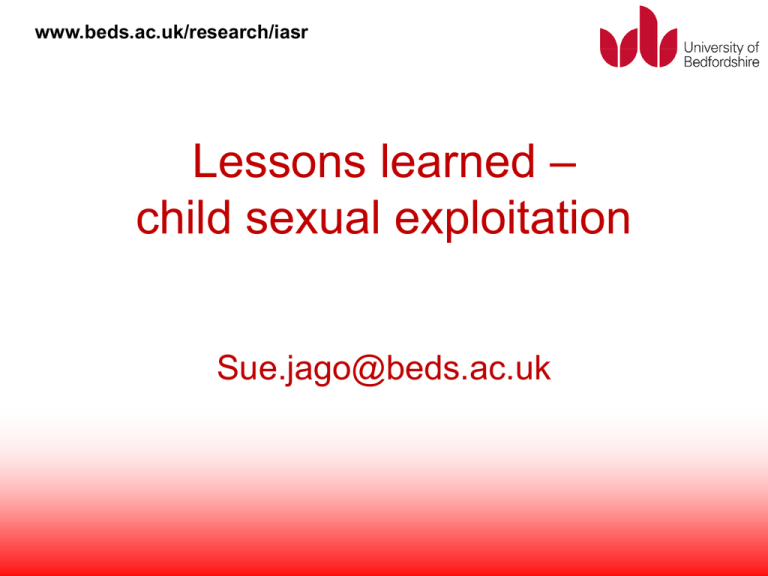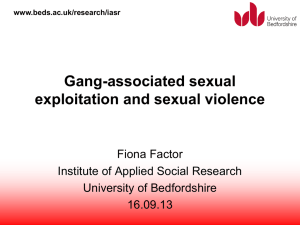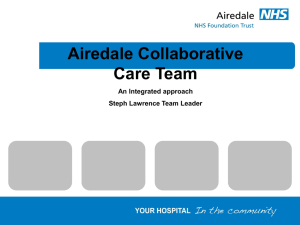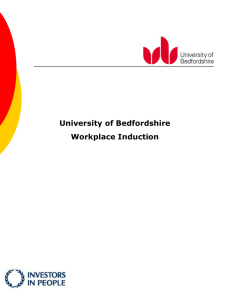
www.beds.ac.uk/research/iasr
Lessons learned –
child sexual exploitation
Sue.jago@beds.ac.uk
www.beds.ac.uk/research/iasr
Headlines last week
• practitioners did not take ‘positive
action’
• lack of understanding by practitioners of
protocols and procedures
• information not shared
• systematic failures highlighted
• need for an overhaul of working
procedures, especially to identify victims
and the risks they face
www.beds.ac.uk/research/iasr
Recent cases including Operation
Retriever
Derby Serious Case Review
What’s Going On to safeguard children
and young people from sexual
exploitation?
www.beds.ac.uk/research/iasr
Research report
• themed findings on the implementation of the
2009 government guidance
• recommendations for action to improve
implementation
• signposting to resources
• a self assessment checklist
A data monitoring tool
A newsletter, What’s Going On?, to inform on
research, policy and practice
www.beds.ac.uk/research/iasr
LSCB coordination
it is not enough for one or two agencies to work hard
“within their own sphere” Derby SCR BD09
• only a quarter of the country working to a current
CSE protocol
• less than a third of the country has a sub group
addressing CSE
www.beds.ac.uk/research/iasr
Joint working
• not seen as an LSCB responsibility
• not a priority
• over-reliance on ‘champions’ or specialist projects
• not recognising value of voluntary sector
• struggling to draw in all relevant agencies
• structures/procedures geared towards familial abuse
• poor partnership working
www.beds.ac.uk/research/iasr
LSCB coordination
Positive results
• implementing the guidance - specific protocol,
driven by a multi-agency sub group
• involvement of senior managers from all relevant
agencies […] coordinated via the LSCB
• roles and responsibilities of all agencies […] clearly
set out and understood, in particular between
voluntary and statutory agencies
• a mix of specialist workers in a co-located unit
www.beds.ac.uk/research/iasr
Identifying child sexual exploitation
universal services – health and education – missed
early signs of concern; when I was at school they didn’t
have a clue, nobody asked me what was wrong
little evidence of agencies working together to
coordinate actions and create a comprehensive picture
of [the young victims’] lives
the older they get the more complex issues become
and the judgement about capacity [to consent] as they
head towards being an adult, society tends to discard
it: “ they chose to get in the car, its their fault”
www.beds.ac.uk/research/iasr
Identifying child sexual exploitation
• less than half the country is raising awareness
with young people
•even fewer with parents/carers
• training for practitioners is piecemeal and
variable
www.beds.ac.uk/research/iasr
Identifying child sexual exploitation
• not recognising the ‘signs, or misreading the ‘signs’
- a failure to understand the impact of coercion by the
abusers on their behaviour and to assess their capacity to
make informed choices, particularly in older teenagers
• limited understanding of the patterns of exploitation not recognising exploitation involving boys and young men,
and young people in BME communities
The potential for poor outcomes increases significantly
when intervention does not take place at an early stage
www.beds.ac.uk/research/iasr
Identifying child sexual exploitation
Positive results
• raising awareness of how exploitation takes place
• staff in all agencies need to be better trained and
equipped to deal with CSE, covering risk indicators and
consent issues
• scoping the issues locally
• linking CSE strategy with associated issues
missing from home/care
gang violence
domestic abuse
• co-locating specialist workers
www.beds.ac.uk/research/iasr
Supporting young people and their parents
staff did not recognise the significance of their
behaviour in terms of abuse and they were dealt with
as ‘rebellious adolescents’
I feel that sometimes there’s an approach and if that
doesn’t work it’s the young person’s fault. If you can’t
get through one way, you need to be always looking
for things that young people are going to latch on to
the most important thing is the relationship, the trust
www.beds.ac.uk/research/iasr
Supporting young people and their parents
• fewer than half of interviewees had an information
sharing protocol
• only just over a third reported that a therapeutic
intervention was available
• fewer than half reported that family support was available
• fewer than half reported that a health intervention was
available
www.beds.ac.uk/research/iasr
Supporting young people and their parents
• child protection thresholds impede early intervention
• focus is on younger children in the home
• sexually exploited young people seen as ‘hard to reach ’
• lack of specialist staff
• family support not widely available; parents often excluded
• difficulties with accessing services, especially CAMHS
• a lack of ‘safe’ accommodation
www.beds.ac.uk/research/iasr
Supporting and protecting young people and
their parents
Positive results
early intervention to address known concerns
• a child-centred approach
• involving young people and parents in decision making
• specialist workers delivering flexible and innovative
interventions
• accessible to all, regardless of age, gender, ethnicity
• a focus on ‘moving on’
• a co-located service
www.beds.ac.uk/research/iasr
Disrupting and prosecuting abusers
if the police come in like they do, rushing in with their
attitudes, the girls won’t sit down and talk to them. But
if they gave the girls a bit more time to help them then
maybe they’d do a bit better
these girls have had the most horrendous time in court,
it has been horrific, it’s abusive…nobody wants to
tackle that
www.beds.ac.uk/research/iasr
Disrupting and prosecuting abusers
• fewer than
half reported a police
operation in the last year
• fewer than a quarter reported
prosecutions in the last year
www.beds.ac.uk/research/iasr
Disrupting and prosecuting abusers
• reluctance of young people to disclose
• confusion over information, intelligence and evidence
• tension between investigation and safeguarding – the
implications of covert policing techniques were not fully
understood
• need for more informed/earlier involvement of the CPS
• lack of support for young people before, during
and after criminal proceedings
• intolerable experiences for young victims in court
www.beds.ac.uk/research/iasr
Disrupting and prosecuting abusers
• identifying and tackling ‘hotspots’
• training on how to report incidents
• an agreed process for information sharing across
agencies
• a clear understanding of the roles and
responsibilities of all agencies and the involvement of
all agencies at the earliest possible stage
• a consideration of resources needed
• a comprehensive multi-agency contingency plan
www.beds.ac.uk/research/iasr
Collecting and managing data
there is masses of information but no one has the time
to record it. It needs managing properly and it needs an
analyst
we have adopted the trial documentation as our local
data collection tool but at present our numbers remain
low […] we need to do more to raise awareness of signs
and symptoms
it [data collection trial] has given us a lot of valuable
information on child sexual exploitation
www.beds.ac.uk/research/iasr
Collecting and managing data
• 1065 young people on one day were
receiving support in England in relation to
child sexual exploitation
• this represents responses from just 33
agencies in England
www.beds.ac.uk/research/iasr
Collecting and managing data
• over half of LSCBs surveyed did not record data
• fewer than half of interviewees reported that
data was collected in their own agencies
• in only one interview area was data collected
at both agency and LSCB level,
using a shared database
www.beds.ac.uk/research/iasr
Collecting and managing data
• child sexual exploitation is not identified – so no data
• data held
• not identified as relating to child sexual
exploitation
• in files, meeting notes and other records
• no collation, no analysis, no understanding of needs
www.beds.ac.uk/research/iasr
Collecting and managing data
Positive results
Consistent use of data monitoring tool, using data to:
• identify local needs and trends
• to raise awareness
• to make a case for resources locally
• to target resources locally
Recs:
• all LSCBs to use data monitoring tool
• an annual national data collection (CEOP)
www.beds.ac.uk/research/iasr
Recommendations
An over-arching conceptual shift in child protection
•
recognise child sexual exploitation as a form
of child abuse
•
extend the remit of child protection so that the
safeguarding needs of older children with
multiple vulnerabilities are addressed
www.beds.ac.uk/research/iasr
Local recommendations
• LSCBs to implement the 2009 guidance
• All LSCB Chairs and Directors of Children’s Services to receive
CSE training
• LSCBs to work towards having a co-located team
• LSCBs to use self assessment checklist
• LSCB inspections to include progress on the dual aim of a child
sexual exploitation strategy
www.beds.ac.uk/research/iasr
National recommendations
• all pre and post qualifying training for professionals
working with young people to include child sexual
exploitation
• an assessment of the availability and
appropriateness of accommodation for children at risk
of / who have experienced sexual exploitation
• a review of child friendly justice
www.beds.ac.uk/research/iasr
What’s Going On to safeguard
children and young people
from sexual exploitation?
Full report available from
www.beds.ac.uk/research/iasr








